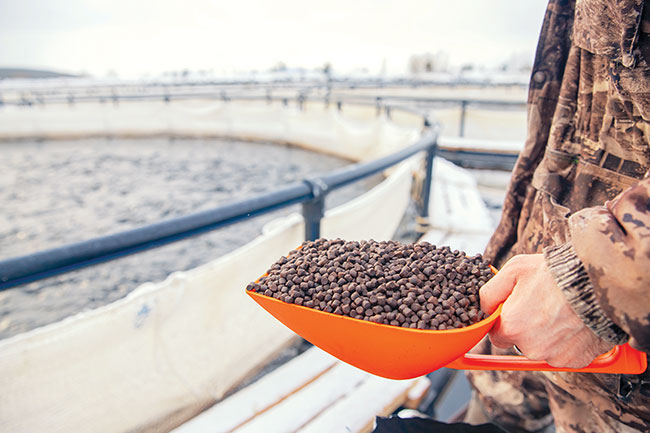
Improving feed offers hope in limiting climate change
February 23, 2022
By
Liza Mayer
 Photo: © Parilov / Adobe Stock
Photo: © Parilov / Adobe Stock Animal nutrition company Cargill has set out an ambitious target of reducing the farmed salmon industry’s carbon footprint by 30 percent per tonne of fish produced by 2030, a goal it likens to removing more than 400,000 cars from the road in one year.
Feed raw materials singlehandedly contribute 50 percent of emissions in aquaculture. How they are produced and how their production affects the land, such as deforestation, accounts for much of that.
Feed’s contribution to aquaculture emissions goes up to as high as 90 percent when feed performance is factored in, such as the how many tons of feed are needed to grow one ton of fish and how much of the feed goes to the water or wasted.
The animal nutrition giant is harnessing its power to effect change.
“Our goal is to help reduce the industry’s footprint by working with our individual customers,” said Dave Robb, sustainability program lead of Cargill’s SeaFurther sustainability program and co-author of the study, “Quantifying greenhouse gas emissions from global aquaculture.”
“As Cargill, we have a real clear role in supporting sustainable development of salmon farming and all fed aquaculture to help our customers set and achieve bold climate goals. If we can manage on the raw material, we can affect at least 50 percent in the footprint of the final animal. And if we can manage on the feed performance, we can manage at least 75 percent, or possibly even more, of the footprint of the animal. So that’s the combination of the feed and using the feed. Those together will of course impact the on-farm inputs and the effluents impact as well,” said Robb.
Aside from quantifying each component of salmon aquaculture up to the point of harvest, the 2020 study found a rather surprising finding: transportation of raw feed materials to the feed mills and transportation of the finished feed to the farm account for just a very small portion of the farming emissions, it said.
“This may be surprising to many people that despite using global supply chains, the overall transport footprint for the raw materials inbound is very small – about two or three percent of the overall footprint of the raw materials,” said Robb, who spoke at the Global Seafood Alliance’s GOAL Conference in November.
Cargill plans to manage footprint of feed and maximize its efficiencies by working with existing suppliers to reduce the footprint of the raw materials that they provide the company; identifying new supply chains and new raw materials; and bringing the nutrients that’s needed to produce healthy fish.
“By doing this at scale with salmon alone, we see that we can save 2 billion kilograms of CO2 between the start of the program (in March 2021) and 2030; that’s equivalent to removing more than 400,000 cars from the road in one year,” said Robb. “We’ve set ourselves a midpoint goal in 2026, when we will have already achieved a 15-percent reduction in greenhouse gases.”
The SeaFurther sustainability program started with the salmon industry first because it is a sector it knows very well, said Robb, but it will roll out the sustainability program to other fed aquaculture species eventually.
“Seventy percent of consumers surveyed across 22 different countries want to know about the seafood they are purchasing, to see that it was produced sustainably. As we scale up our production to help feed the world going through the growing population in 2030 and 2050, we’re going to play an increasing part of the overall footprint of food production,” he said.
Advertisement
- XpertSea names new chief sustainability officer
- More than 4,700 jobs, $1.2 billion at stake in BC coast: BCFSA report





